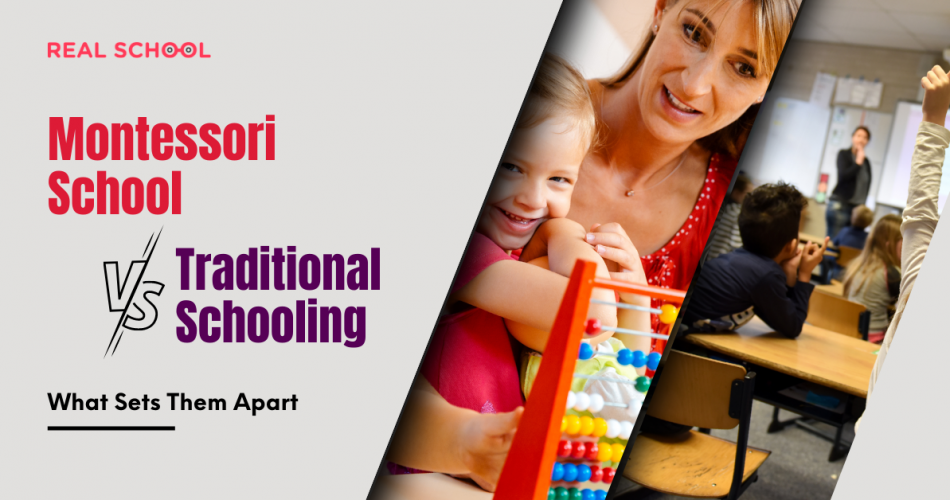Introduction
Education is the cornerstone of a child’s development, and choosing the right educational approach is crucial for their growth and future success. Montessori schools and traditional schooling represent two distinct philosophies of education. In this article, we will explore the key differences between Montessori schools and traditional schooling, helping parents make informed decisions about the best educational option for their children.
-
Philosophy and Approach
The fundamental difference between Montessori schools and traditional schooling lies in their educational philosophy and approach. Montessori education emphasizes child-centered learning, where students take an active role in their education and follow their interests. Traditional schooling, on the other hand, adopts a teacher-centered approach, where instructors deliver standardized content to a group of students.
-
Learning Environment
Montessori classrooms are designed to be child-friendly, encouraging exploration and independence. The environment is carefully arranged with age-appropriate learning materials that engage the senses and promote hands-on learning. In contrast, traditional classrooms often have a more structured layout, with desks facing the front and limited opportunities for interactive learning.
-
Role of the Teacher
In Montessori schools, teachers act as guides and facilitators, observing and supporting each child’s individual progress. They encourage self-directed learning and offer guidance when needed. In traditional schooling, teachers play a more authoritative role, imparting knowledge through lectures and leading classroom activities.
-
Curriculum and Learning Materials
Montessori education follows a child-centered, holistic curriculum that spans various subjects. The learning materials in Montessori classrooms are carefully selected to cater to different learning styles and developmental stages. Traditional schooling adheres to a standardized curriculum set by educational boards and typically uses textbooks and worksheets for instruction.
-
Approach to Learning
Montessori education promotes self-directed learning, allowing students to choose their activities based on their interests and learning pace. This approach fosters intrinsic motivation and a love for learning. Traditional schooling relies on a structured curriculum with set timelines for completing lessons, focusing on meeting specific academic standards.
-
Assessment and Evaluation
Assessment methods differ between Montessori schools and traditional schooling. Montessori education employs qualitative assessments, with teachers observing and documenting a child’s progress based on individual milestones. Traditional schooling often relies on quantitative measures, such as tests and exams, to evaluate students’ performance.
-
Mixed-Age Grouping
Montessori classrooms typically include students of different ages, fostering a collaborative and supportive learning environment. Older children act as mentors, and younger ones learn from their peers. Traditional schooling generally groups students by age, with limited interaction between different age groups.
-
Emphasis on Practical Life Skills
Montessori education places a strong emphasis on practical life skills, such as self-care, cooking, and cleaning. These skills are integrated into the curriculum to promote independence and responsibility. Traditional schooling may include life skills education, but it is often less prominent than in Montessori education.
-
Creativity and Critical Thinking
Montessori schools encourage creativity and critical thinking through open-ended learning materials and problem-solving activities. Traditional schooling also promotes these skills, but the emphasis may vary depending on the specific teaching methods used.
-
Social and Emotional Development
Both Montessori schools and traditional schooling recognize the importance of social and emotional development. Montessori education, with its mixed-age classrooms and emphasis on community, provides ample opportunities for social growth. Traditional schooling also fosters social interactions but may do so within the confines of same-age peer groups.
Conclusion
In conclusion, Montessori schools and traditional schooling differ significantly in their educational philosophies, approaches, and learning environments. Montessori education emphasizes child-centered learning, independence, and hands-on exploration, while traditional schooling follows a more structured, teacher-centered approach. Each approach has its unique strengths and benefits, and the choice between the two ultimately depends on the individual needs and preferences of the child and their family.
FAQs (Frequently Asked Questions)
Which approach is better: Montessori or traditional schooling?
Can a child transition from Montessori to traditional schooling, or vice versa?
What are the main advantages of Montessori education?
How does the role of a teacher differ in Montessori and traditional classrooms?
Are there specific age groups that benefit more from Montessori schools?







